Strategic Use of Cloud Accounting Information Systems: A Report
VerifiedAdded on 2021/02/19
|9
|2407
|82
Report
AI Summary
This report provides a comprehensive analysis of Accounting Information Systems (AIS), focusing on the strategic use of cloud-based accounting solutions. It begins by defining AIS and outlining its core functions, including data collection, processing, and information dissemination to stakeholders such as creditors, tax authorities, and investors. The report then delves into cloud accounting, differentiating between Software as a Service (SaaS) and Platform as a Service (PaaS) models. SaaS is examined for its cost-effectiveness, flexibility, and the limitations associated with lack of control, while PaaS is explored for its role in facilitating application development within the cloud environment. The report highlights the strategic value of cloud accounting in terms of democratized technology, innovation, and rapid experimentation, while also acknowledging potential security concerns and the importance of understanding compatibility issues. Finally, the report concludes by summarizing the key benefits of cloud accounting systems, emphasizing their role in enabling informed decision-making and driving innovation within organizations.
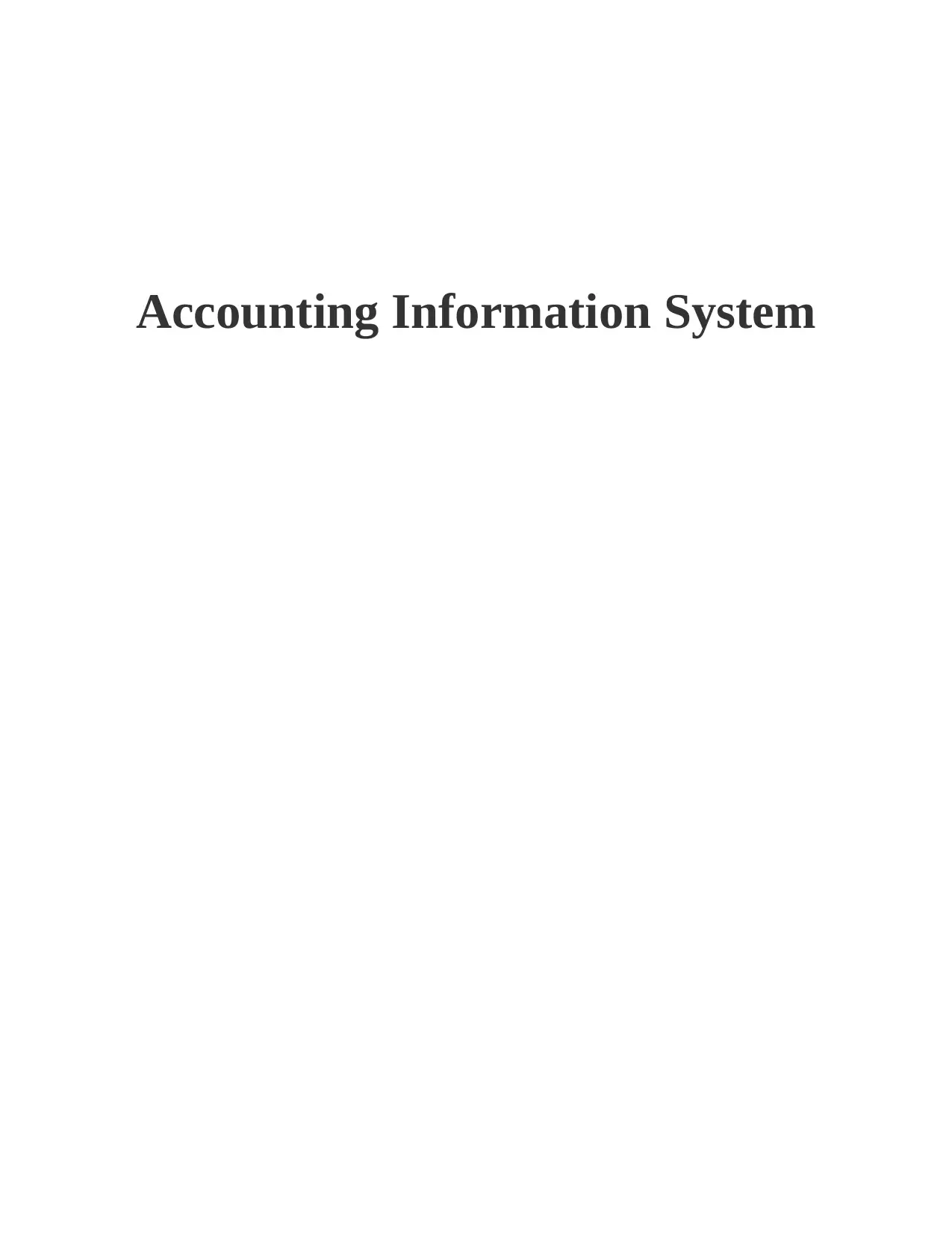
Accounting Information System
Paraphrase This Document
Need a fresh take? Get an instant paraphrase of this document with our AI Paraphraser
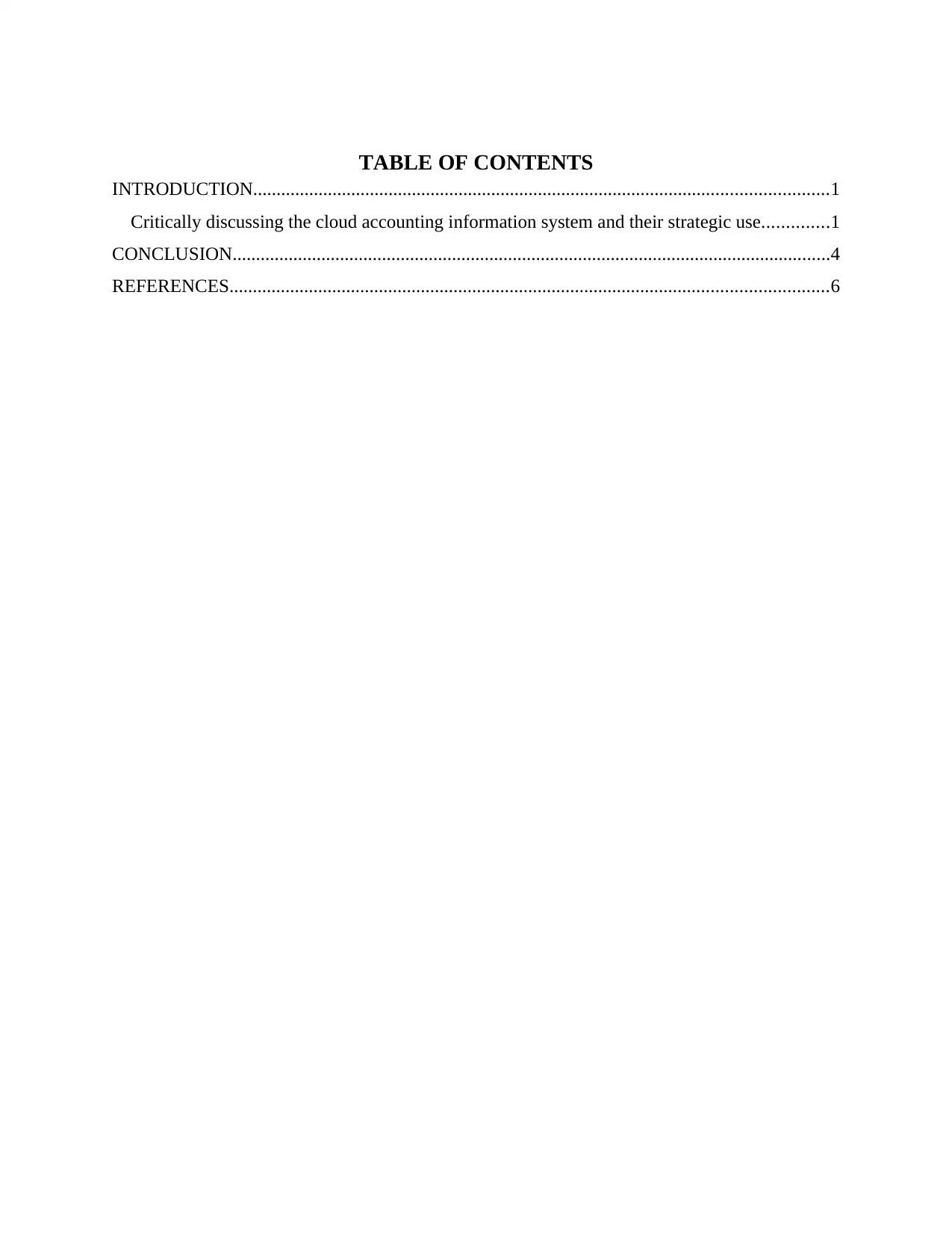
TABLE OF CONTENTS
INTRODUCTION...........................................................................................................................1
Critically discussing the cloud accounting information system and their strategic use..............1
CONCLUSION................................................................................................................................4
REFERENCES................................................................................................................................6
INTRODUCTION...........................................................................................................................1
Critically discussing the cloud accounting information system and their strategic use..............1
CONCLUSION................................................................................................................................4
REFERENCES................................................................................................................................6
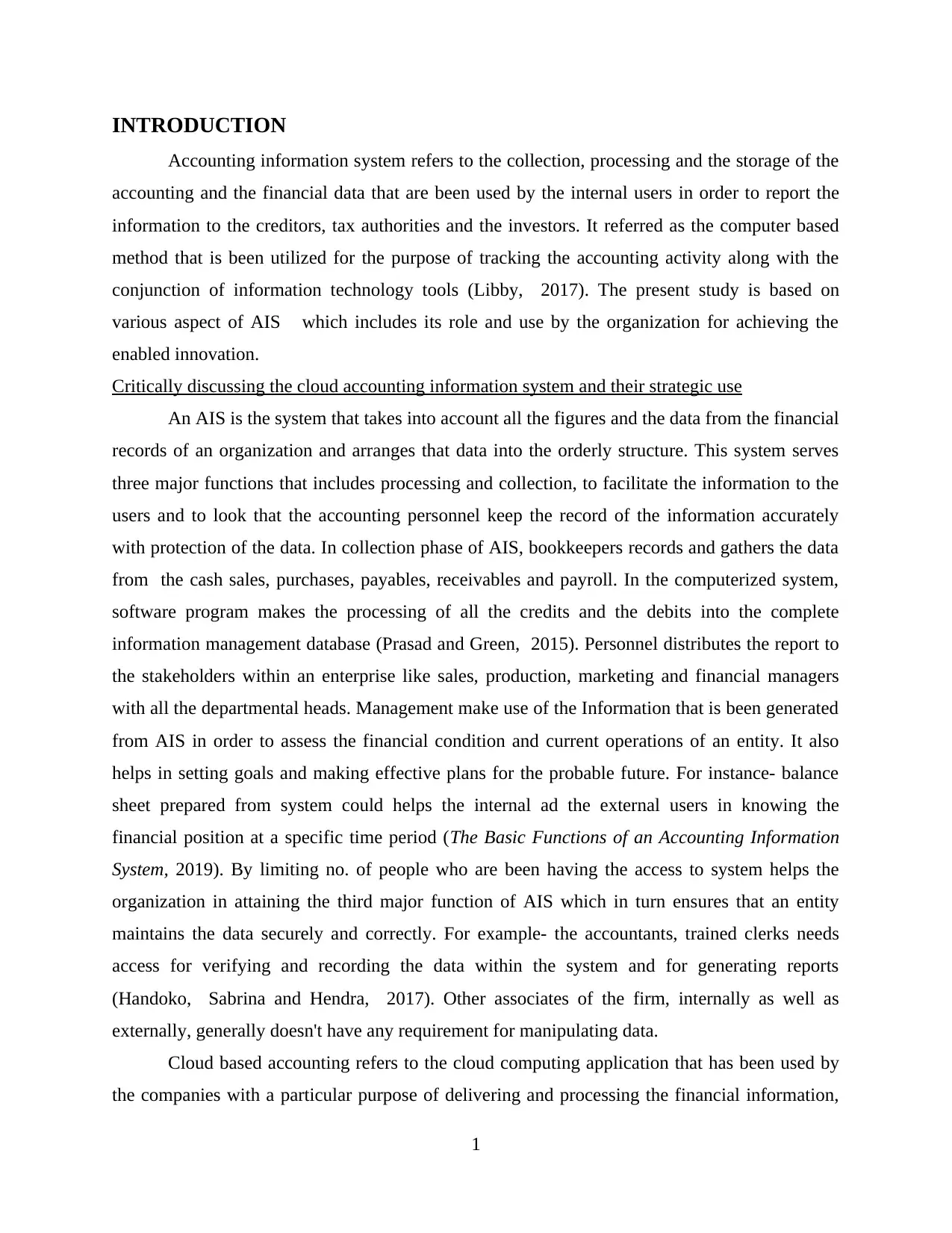
INTRODUCTION
Accounting information system refers to the collection, processing and the storage of the
accounting and the financial data that are been used by the internal users in order to report the
information to the creditors, tax authorities and the investors. It referred as the computer based
method that is been utilized for the purpose of tracking the accounting activity along with the
conjunction of information technology tools (Libby, 2017). The present study is based on
various aspect of AIS which includes its role and use by the organization for achieving the
enabled innovation.
Critically discussing the cloud accounting information system and their strategic use
An AIS is the system that takes into account all the figures and the data from the financial
records of an organization and arranges that data into the orderly structure. This system serves
three major functions that includes processing and collection, to facilitate the information to the
users and to look that the accounting personnel keep the record of the information accurately
with protection of the data. In collection phase of AIS, bookkeepers records and gathers the data
from the cash sales, purchases, payables, receivables and payroll. In the computerized system,
software program makes the processing of all the credits and the debits into the complete
information management database (Prasad and Green, 2015). Personnel distributes the report to
the stakeholders within an enterprise like sales, production, marketing and financial managers
with all the departmental heads. Management make use of the Information that is been generated
from AIS in order to assess the financial condition and current operations of an entity. It also
helps in setting goals and making effective plans for the probable future. For instance- balance
sheet prepared from system could helps the internal ad the external users in knowing the
financial position at a specific time period (The Basic Functions of an Accounting Information
System, 2019). By limiting no. of people who are been having the access to system helps the
organization in attaining the third major function of AIS which in turn ensures that an entity
maintains the data securely and correctly. For example- the accountants, trained clerks needs
access for verifying and recording the data within the system and for generating reports
(Handoko, Sabrina and Hendra, 2017). Other associates of the firm, internally as well as
externally, generally doesn't have any requirement for manipulating data.
Cloud based accounting refers to the cloud computing application that has been used by
the companies with a particular purpose of delivering and processing the financial information,
1
Accounting information system refers to the collection, processing and the storage of the
accounting and the financial data that are been used by the internal users in order to report the
information to the creditors, tax authorities and the investors. It referred as the computer based
method that is been utilized for the purpose of tracking the accounting activity along with the
conjunction of information technology tools (Libby, 2017). The present study is based on
various aspect of AIS which includes its role and use by the organization for achieving the
enabled innovation.
Critically discussing the cloud accounting information system and their strategic use
An AIS is the system that takes into account all the figures and the data from the financial
records of an organization and arranges that data into the orderly structure. This system serves
three major functions that includes processing and collection, to facilitate the information to the
users and to look that the accounting personnel keep the record of the information accurately
with protection of the data. In collection phase of AIS, bookkeepers records and gathers the data
from the cash sales, purchases, payables, receivables and payroll. In the computerized system,
software program makes the processing of all the credits and the debits into the complete
information management database (Prasad and Green, 2015). Personnel distributes the report to
the stakeholders within an enterprise like sales, production, marketing and financial managers
with all the departmental heads. Management make use of the Information that is been generated
from AIS in order to assess the financial condition and current operations of an entity. It also
helps in setting goals and making effective plans for the probable future. For instance- balance
sheet prepared from system could helps the internal ad the external users in knowing the
financial position at a specific time period (The Basic Functions of an Accounting Information
System, 2019). By limiting no. of people who are been having the access to system helps the
organization in attaining the third major function of AIS which in turn ensures that an entity
maintains the data securely and correctly. For example- the accountants, trained clerks needs
access for verifying and recording the data within the system and for generating reports
(Handoko, Sabrina and Hendra, 2017). Other associates of the firm, internally as well as
externally, generally doesn't have any requirement for manipulating data.
Cloud based accounting refers to the cloud computing application that has been used by
the companies with a particular purpose of delivering and processing the financial information,
1
⊘ This is a preview!⊘
Do you want full access?
Subscribe today to unlock all pages.

Trusted by 1+ million students worldwide
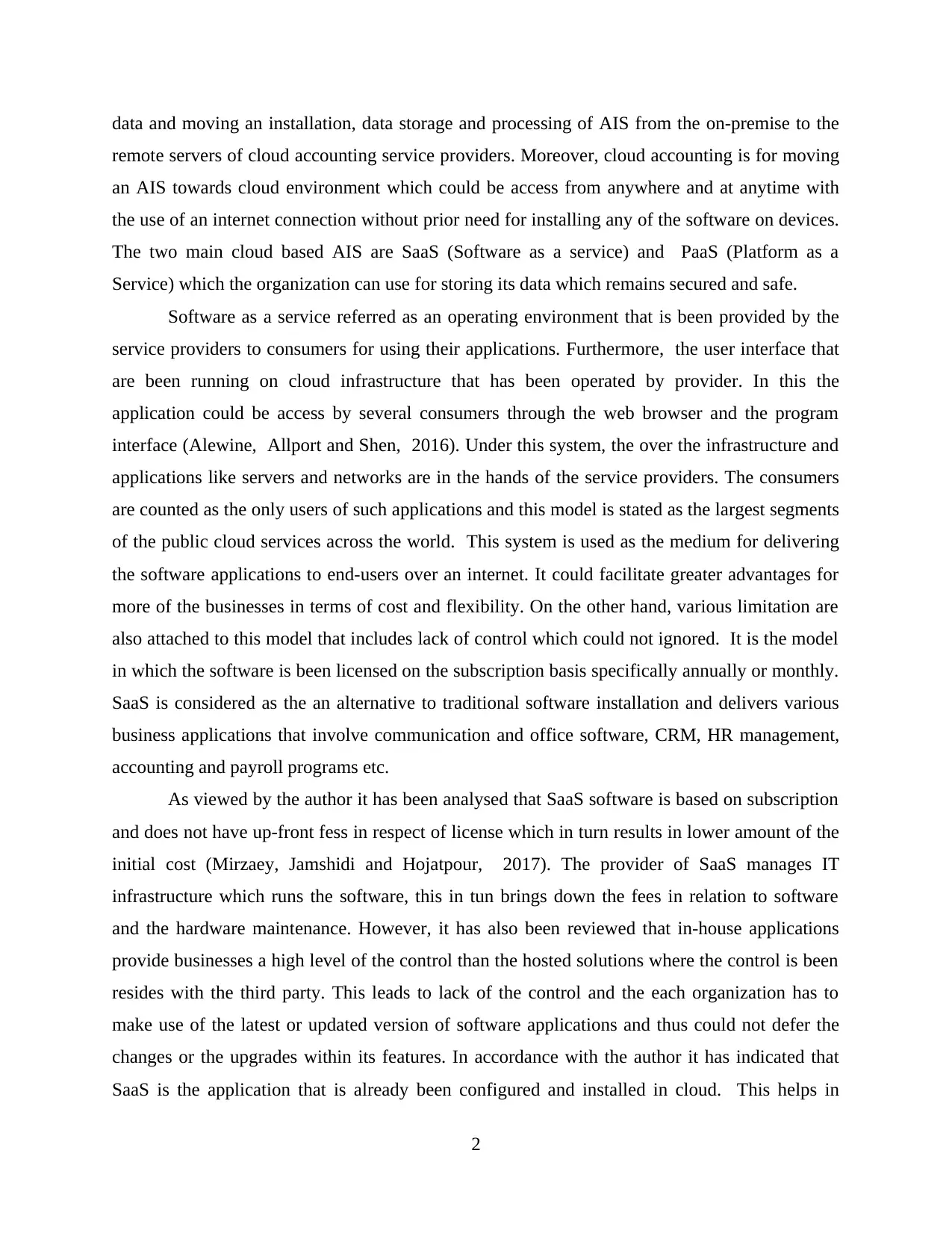
data and moving an installation, data storage and processing of AIS from the on-premise to the
remote servers of cloud accounting service providers. Moreover, cloud accounting is for moving
an AIS towards cloud environment which could be access from anywhere and at anytime with
the use of an internet connection without prior need for installing any of the software on devices.
The two main cloud based AIS are SaaS (Software as a service) and PaaS (Platform as a
Service) which the organization can use for storing its data which remains secured and safe.
Software as a service referred as an operating environment that is been provided by the
service providers to consumers for using their applications. Furthermore, the user interface that
are been running on cloud infrastructure that has been operated by provider. In this the
application could be access by several consumers through the web browser and the program
interface (Alewine, Allport and Shen, 2016). Under this system, the over the infrastructure and
applications like servers and networks are in the hands of the service providers. The consumers
are counted as the only users of such applications and this model is stated as the largest segments
of the public cloud services across the world. This system is used as the medium for delivering
the software applications to end-users over an internet. It could facilitate greater advantages for
more of the businesses in terms of cost and flexibility. On the other hand, various limitation are
also attached to this model that includes lack of control which could not ignored. It is the model
in which the software is been licensed on the subscription basis specifically annually or monthly.
SaaS is considered as the an alternative to traditional software installation and delivers various
business applications that involve communication and office software, CRM, HR management,
accounting and payroll programs etc.
As viewed by the author it has been analysed that SaaS software is based on subscription
and does not have up-front fess in respect of license which in turn results in lower amount of the
initial cost (Mirzaey, Jamshidi and Hojatpour, 2017). The provider of SaaS manages IT
infrastructure which runs the software, this in tun brings down the fees in relation to software
and the hardware maintenance. However, it has also been reviewed that in-house applications
provide businesses a high level of the control than the hosted solutions where the control is been
resides with the third party. This leads to lack of the control and the each organization has to
make use of the latest or updated version of software applications and thus could not defer the
changes or the upgrades within its features. In accordance with the author it has indicated that
SaaS is the application that is already been configured and installed in cloud. This helps in
2
remote servers of cloud accounting service providers. Moreover, cloud accounting is for moving
an AIS towards cloud environment which could be access from anywhere and at anytime with
the use of an internet connection without prior need for installing any of the software on devices.
The two main cloud based AIS are SaaS (Software as a service) and PaaS (Platform as a
Service) which the organization can use for storing its data which remains secured and safe.
Software as a service referred as an operating environment that is been provided by the
service providers to consumers for using their applications. Furthermore, the user interface that
are been running on cloud infrastructure that has been operated by provider. In this the
application could be access by several consumers through the web browser and the program
interface (Alewine, Allport and Shen, 2016). Under this system, the over the infrastructure and
applications like servers and networks are in the hands of the service providers. The consumers
are counted as the only users of such applications and this model is stated as the largest segments
of the public cloud services across the world. This system is used as the medium for delivering
the software applications to end-users over an internet. It could facilitate greater advantages for
more of the businesses in terms of cost and flexibility. On the other hand, various limitation are
also attached to this model that includes lack of control which could not ignored. It is the model
in which the software is been licensed on the subscription basis specifically annually or monthly.
SaaS is considered as the an alternative to traditional software installation and delivers various
business applications that involve communication and office software, CRM, HR management,
accounting and payroll programs etc.
As viewed by the author it has been analysed that SaaS software is based on subscription
and does not have up-front fess in respect of license which in turn results in lower amount of the
initial cost (Mirzaey, Jamshidi and Hojatpour, 2017). The provider of SaaS manages IT
infrastructure which runs the software, this in tun brings down the fees in relation to software
and the hardware maintenance. However, it has also been reviewed that in-house applications
provide businesses a high level of the control than the hosted solutions where the control is been
resides with the third party. This leads to lack of the control and the each organization has to
make use of the latest or updated version of software applications and thus could not defer the
changes or the upgrades within its features. In accordance with the author it has indicated that
SaaS is the application that is already been configured and installed in cloud. This helps in
2
Paraphrase This Document
Need a fresh take? Get an instant paraphrase of this document with our AI Paraphraser
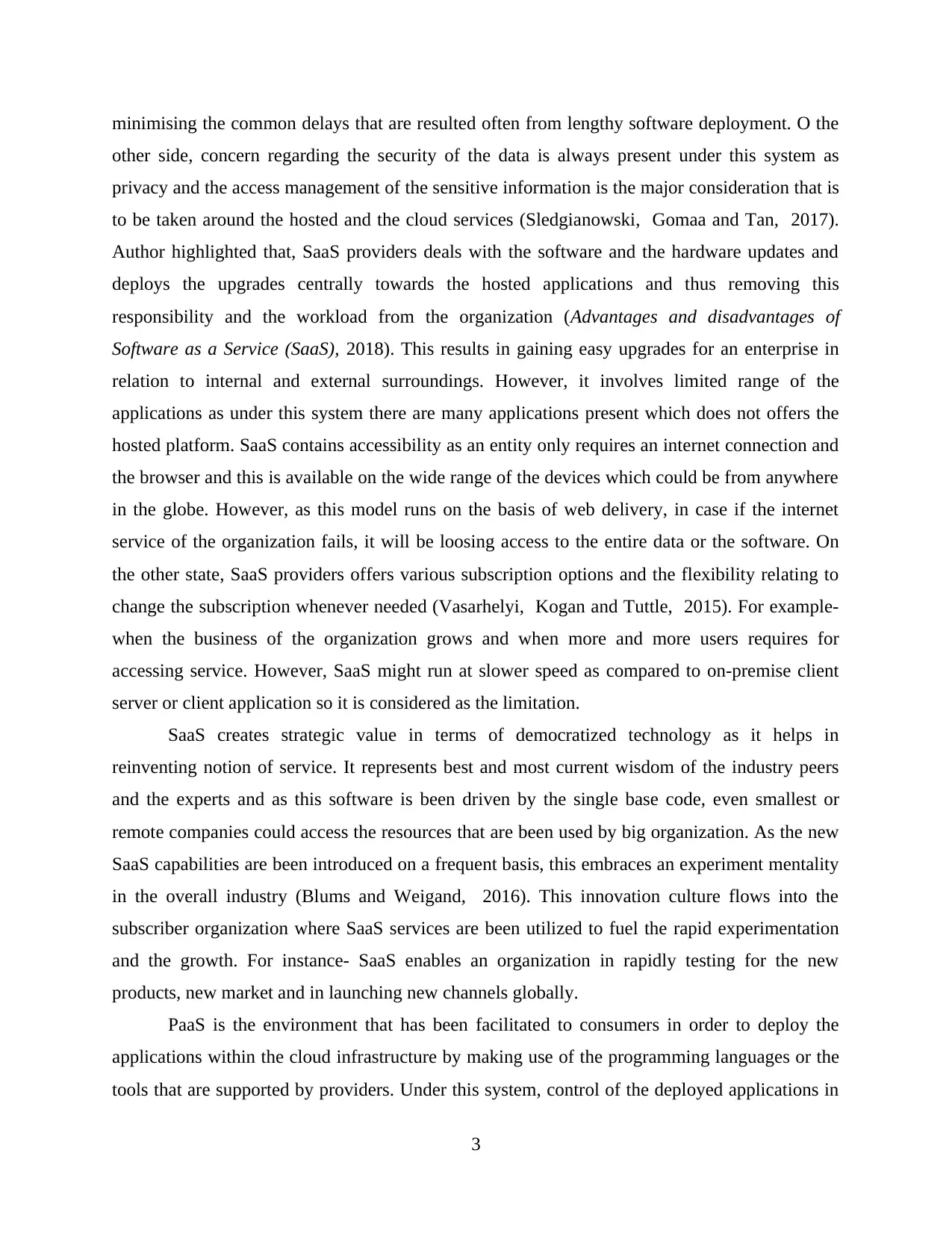
minimising the common delays that are resulted often from lengthy software deployment. O the
other side, concern regarding the security of the data is always present under this system as
privacy and the access management of the sensitive information is the major consideration that is
to be taken around the hosted and the cloud services (Sledgianowski, Gomaa and Tan, 2017).
Author highlighted that, SaaS providers deals with the software and the hardware updates and
deploys the upgrades centrally towards the hosted applications and thus removing this
responsibility and the workload from the organization (Advantages and disadvantages of
Software as a Service (SaaS), 2018). This results in gaining easy upgrades for an enterprise in
relation to internal and external surroundings. However, it involves limited range of the
applications as under this system there are many applications present which does not offers the
hosted platform. SaaS contains accessibility as an entity only requires an internet connection and
the browser and this is available on the wide range of the devices which could be from anywhere
in the globe. However, as this model runs on the basis of web delivery, in case if the internet
service of the organization fails, it will be loosing access to the entire data or the software. On
the other state, SaaS providers offers various subscription options and the flexibility relating to
change the subscription whenever needed (Vasarhelyi, Kogan and Tuttle, 2015). For example-
when the business of the organization grows and when more and more users requires for
accessing service. However, SaaS might run at slower speed as compared to on-premise client
server or client application so it is considered as the limitation.
SaaS creates strategic value in terms of democratized technology as it helps in
reinventing notion of service. It represents best and most current wisdom of the industry peers
and the experts and as this software is been driven by the single base code, even smallest or
remote companies could access the resources that are been used by big organization. As the new
SaaS capabilities are been introduced on a frequent basis, this embraces an experiment mentality
in the overall industry (Blums and Weigand, 2016). This innovation culture flows into the
subscriber organization where SaaS services are been utilized to fuel the rapid experimentation
and the growth. For instance- SaaS enables an organization in rapidly testing for the new
products, new market and in launching new channels globally.
PaaS is the environment that has been facilitated to consumers in order to deploy the
applications within the cloud infrastructure by making use of the programming languages or the
tools that are supported by providers. Under this system, control of the deployed applications in
3
other side, concern regarding the security of the data is always present under this system as
privacy and the access management of the sensitive information is the major consideration that is
to be taken around the hosted and the cloud services (Sledgianowski, Gomaa and Tan, 2017).
Author highlighted that, SaaS providers deals with the software and the hardware updates and
deploys the upgrades centrally towards the hosted applications and thus removing this
responsibility and the workload from the organization (Advantages and disadvantages of
Software as a Service (SaaS), 2018). This results in gaining easy upgrades for an enterprise in
relation to internal and external surroundings. However, it involves limited range of the
applications as under this system there are many applications present which does not offers the
hosted platform. SaaS contains accessibility as an entity only requires an internet connection and
the browser and this is available on the wide range of the devices which could be from anywhere
in the globe. However, as this model runs on the basis of web delivery, in case if the internet
service of the organization fails, it will be loosing access to the entire data or the software. On
the other state, SaaS providers offers various subscription options and the flexibility relating to
change the subscription whenever needed (Vasarhelyi, Kogan and Tuttle, 2015). For example-
when the business of the organization grows and when more and more users requires for
accessing service. However, SaaS might run at slower speed as compared to on-premise client
server or client application so it is considered as the limitation.
SaaS creates strategic value in terms of democratized technology as it helps in
reinventing notion of service. It represents best and most current wisdom of the industry peers
and the experts and as this software is been driven by the single base code, even smallest or
remote companies could access the resources that are been used by big organization. As the new
SaaS capabilities are been introduced on a frequent basis, this embraces an experiment mentality
in the overall industry (Blums and Weigand, 2016). This innovation culture flows into the
subscriber organization where SaaS services are been utilized to fuel the rapid experimentation
and the growth. For instance- SaaS enables an organization in rapidly testing for the new
products, new market and in launching new channels globally.
PaaS is the environment that has been facilitated to consumers in order to deploy the
applications within the cloud infrastructure by making use of the programming languages or the
tools that are supported by providers. Under this system, control of the deployed applications in
3
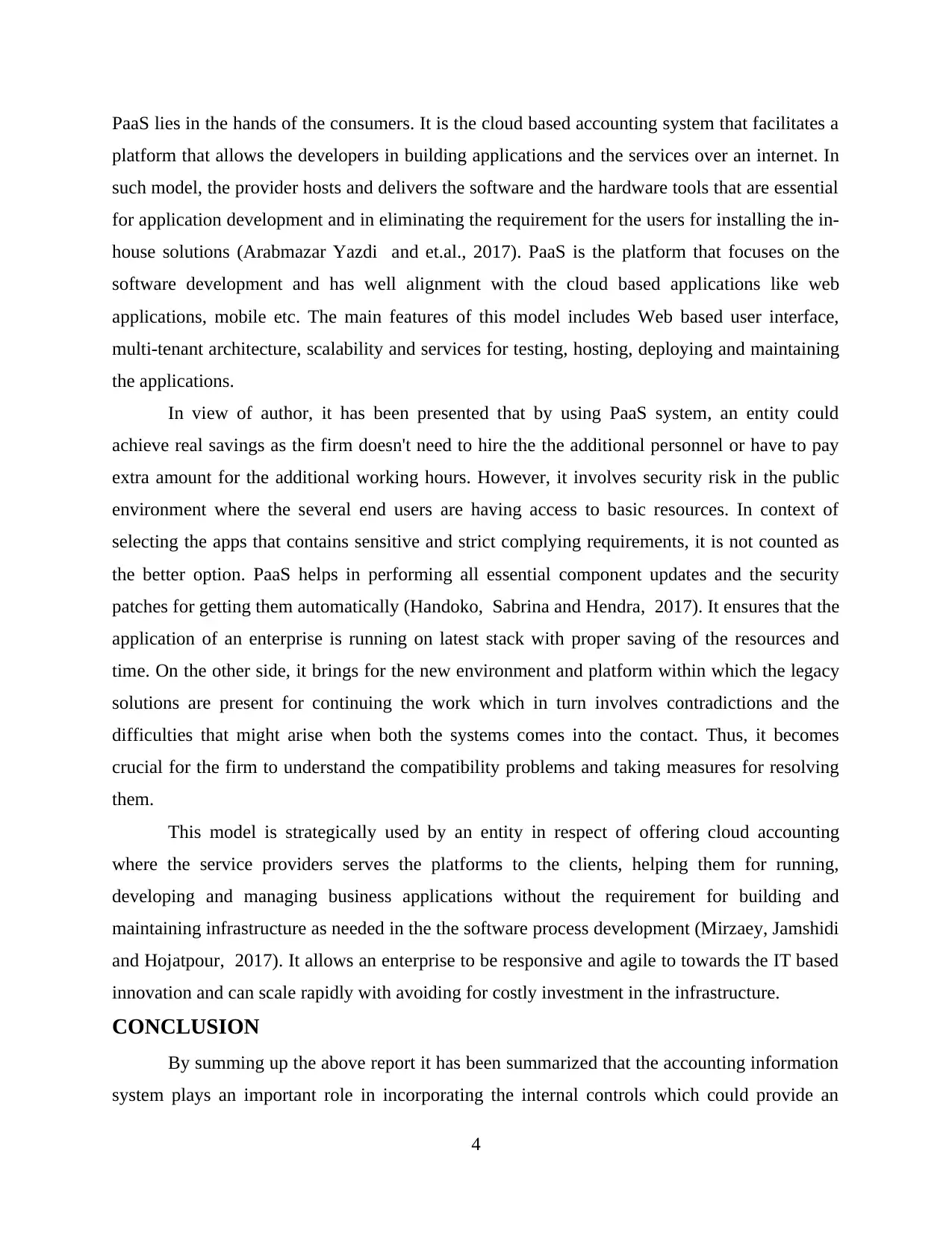
PaaS lies in the hands of the consumers. It is the cloud based accounting system that facilitates a
platform that allows the developers in building applications and the services over an internet. In
such model, the provider hosts and delivers the software and the hardware tools that are essential
for application development and in eliminating the requirement for the users for installing the in-
house solutions (Arabmazar Yazdi and et.al., 2017). PaaS is the platform that focuses on the
software development and has well alignment with the cloud based applications like web
applications, mobile etc. The main features of this model includes Web based user interface,
multi-tenant architecture, scalability and services for testing, hosting, deploying and maintaining
the applications.
In view of author, it has been presented that by using PaaS system, an entity could
achieve real savings as the firm doesn't need to hire the the additional personnel or have to pay
extra amount for the additional working hours. However, it involves security risk in the public
environment where the several end users are having access to basic resources. In context of
selecting the apps that contains sensitive and strict complying requirements, it is not counted as
the better option. PaaS helps in performing all essential component updates and the security
patches for getting them automatically (Handoko, Sabrina and Hendra, 2017). It ensures that the
application of an enterprise is running on latest stack with proper saving of the resources and
time. On the other side, it brings for the new environment and platform within which the legacy
solutions are present for continuing the work which in turn involves contradictions and the
difficulties that might arise when both the systems comes into the contact. Thus, it becomes
crucial for the firm to understand the compatibility problems and taking measures for resolving
them.
This model is strategically used by an entity in respect of offering cloud accounting
where the service providers serves the platforms to the clients, helping them for running,
developing and managing business applications without the requirement for building and
maintaining infrastructure as needed in the the software process development (Mirzaey, Jamshidi
and Hojatpour, 2017). It allows an enterprise to be responsive and agile to towards the IT based
innovation and can scale rapidly with avoiding for costly investment in the infrastructure.
CONCLUSION
By summing up the above report it has been summarized that the accounting information
system plays an important role in incorporating the internal controls which could provide an
4
platform that allows the developers in building applications and the services over an internet. In
such model, the provider hosts and delivers the software and the hardware tools that are essential
for application development and in eliminating the requirement for the users for installing the in-
house solutions (Arabmazar Yazdi and et.al., 2017). PaaS is the platform that focuses on the
software development and has well alignment with the cloud based applications like web
applications, mobile etc. The main features of this model includes Web based user interface,
multi-tenant architecture, scalability and services for testing, hosting, deploying and maintaining
the applications.
In view of author, it has been presented that by using PaaS system, an entity could
achieve real savings as the firm doesn't need to hire the the additional personnel or have to pay
extra amount for the additional working hours. However, it involves security risk in the public
environment where the several end users are having access to basic resources. In context of
selecting the apps that contains sensitive and strict complying requirements, it is not counted as
the better option. PaaS helps in performing all essential component updates and the security
patches for getting them automatically (Handoko, Sabrina and Hendra, 2017). It ensures that the
application of an enterprise is running on latest stack with proper saving of the resources and
time. On the other side, it brings for the new environment and platform within which the legacy
solutions are present for continuing the work which in turn involves contradictions and the
difficulties that might arise when both the systems comes into the contact. Thus, it becomes
crucial for the firm to understand the compatibility problems and taking measures for resolving
them.
This model is strategically used by an entity in respect of offering cloud accounting
where the service providers serves the platforms to the clients, helping them for running,
developing and managing business applications without the requirement for building and
maintaining infrastructure as needed in the the software process development (Mirzaey, Jamshidi
and Hojatpour, 2017). It allows an enterprise to be responsive and agile to towards the IT based
innovation and can scale rapidly with avoiding for costly investment in the infrastructure.
CONCLUSION
By summing up the above report it has been summarized that the accounting information
system plays an important role in incorporating the internal controls which could provide an
4
⊘ This is a preview!⊘
Do you want full access?
Subscribe today to unlock all pages.

Trusted by 1+ million students worldwide
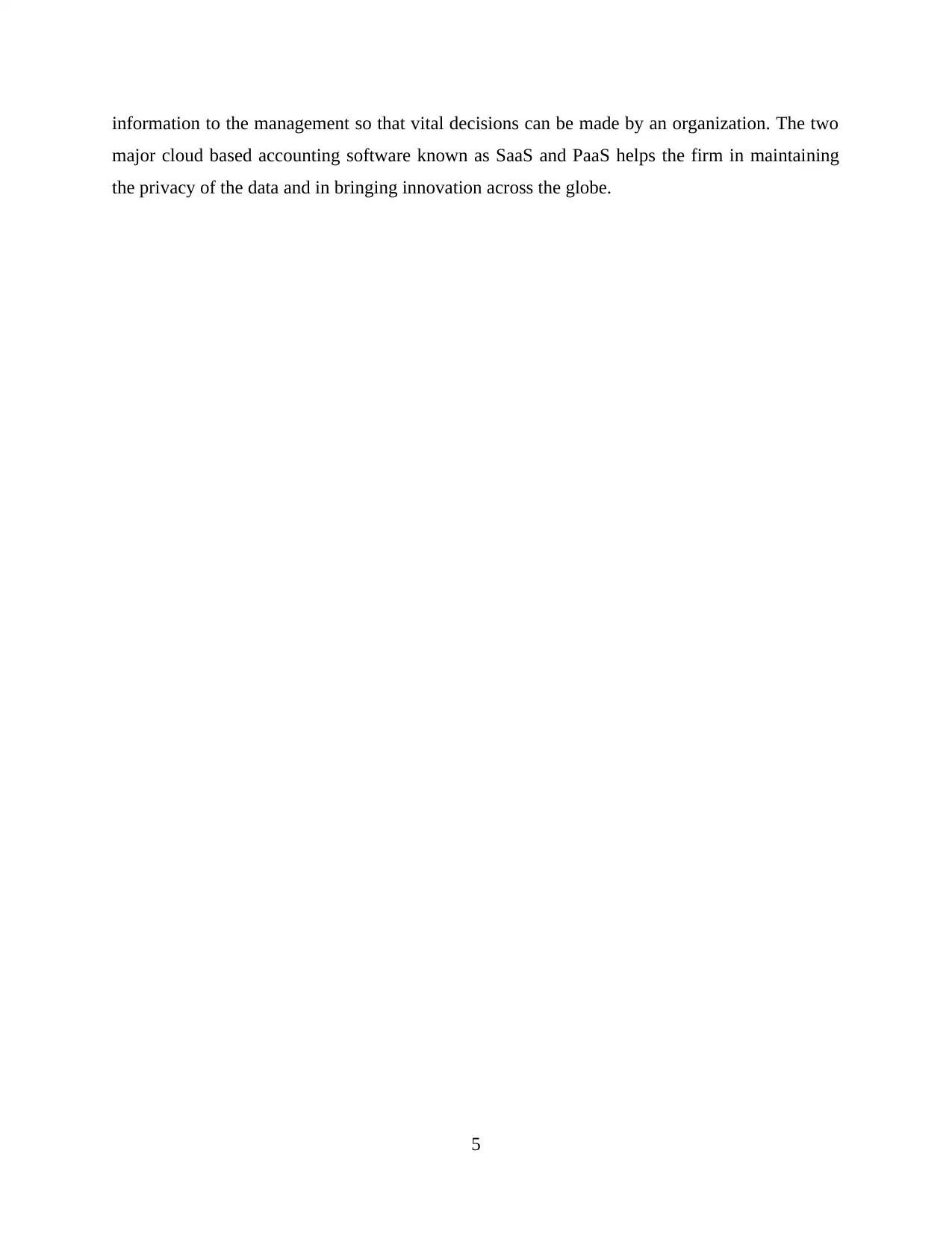
information to the management so that vital decisions can be made by an organization. The two
major cloud based accounting software known as SaaS and PaaS helps the firm in maintaining
the privacy of the data and in bringing innovation across the globe.
5
major cloud based accounting software known as SaaS and PaaS helps the firm in maintaining
the privacy of the data and in bringing innovation across the globe.
5
Paraphrase This Document
Need a fresh take? Get an instant paraphrase of this document with our AI Paraphraser
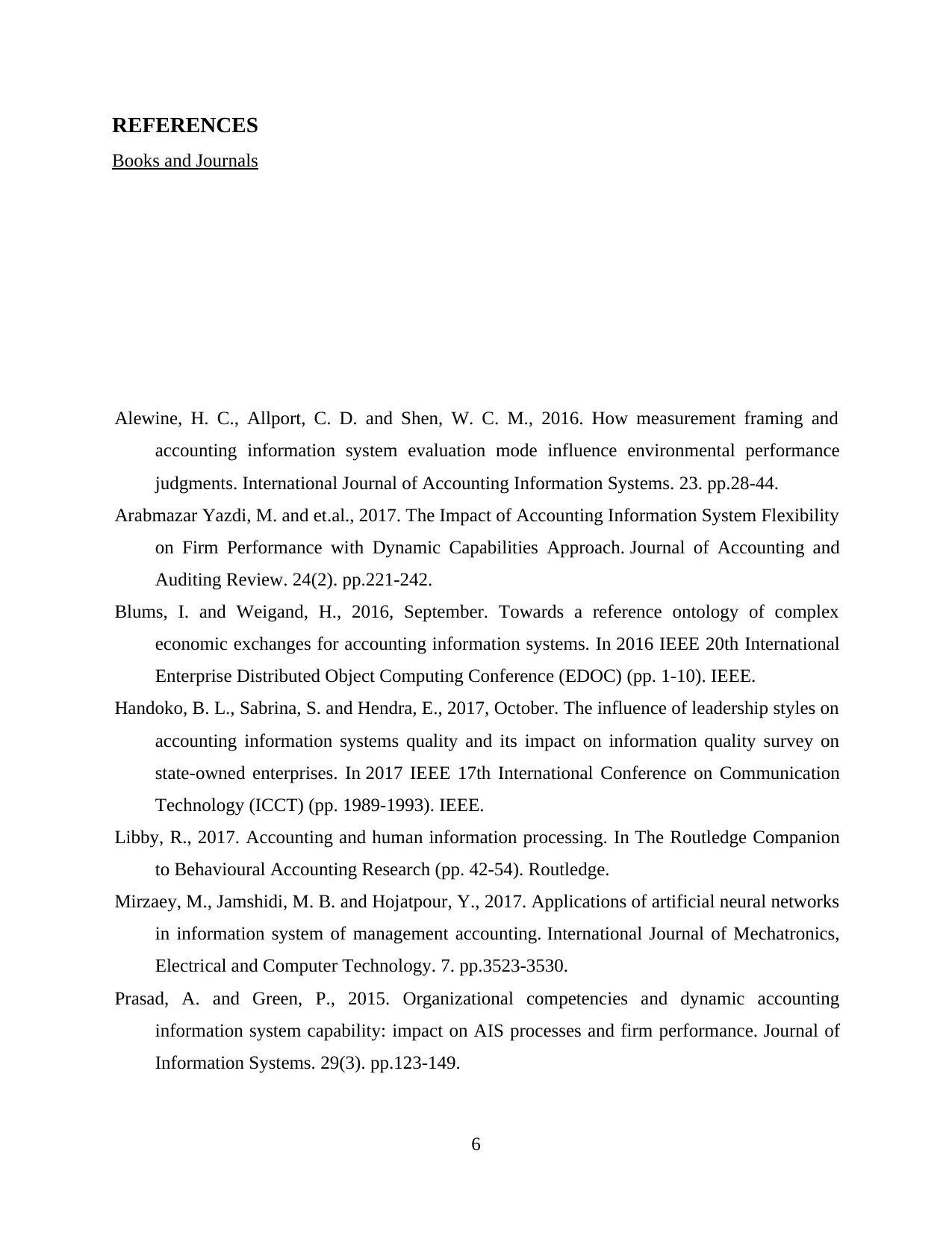
REFERENCES
Books and Journals
Alewine, H. C., Allport, C. D. and Shen, W. C. M., 2016. How measurement framing and
accounting information system evaluation mode influence environmental performance
judgments. International Journal of Accounting Information Systems. 23. pp.28-44.
Arabmazar Yazdi, M. and et.al., 2017. The Impact of Accounting Information System Flexibility
on Firm Performance with Dynamic Capabilities Approach. Journal of Accounting and
Auditing Review. 24(2). pp.221-242.
Blums, I. and Weigand, H., 2016, September. Towards a reference ontology of complex
economic exchanges for accounting information systems. In 2016 IEEE 20th International
Enterprise Distributed Object Computing Conference (EDOC) (pp. 1-10). IEEE.
Handoko, B. L., Sabrina, S. and Hendra, E., 2017, October. The influence of leadership styles on
accounting information systems quality and its impact on information quality survey on
state-owned enterprises. In 2017 IEEE 17th International Conference on Communication
Technology (ICCT) (pp. 1989-1993). IEEE.
Libby, R., 2017. Accounting and human information processing. In The Routledge Companion
to Behavioural Accounting Research (pp. 42-54). Routledge.
Mirzaey, M., Jamshidi, M. B. and Hojatpour, Y., 2017. Applications of artificial neural networks
in information system of management accounting. International Journal of Mechatronics,
Electrical and Computer Technology. 7. pp.3523-3530.
Prasad, A. and Green, P., 2015. Organizational competencies and dynamic accounting
information system capability: impact on AIS processes and firm performance. Journal of
Information Systems. 29(3). pp.123-149.
6
Books and Journals
Alewine, H. C., Allport, C. D. and Shen, W. C. M., 2016. How measurement framing and
accounting information system evaluation mode influence environmental performance
judgments. International Journal of Accounting Information Systems. 23. pp.28-44.
Arabmazar Yazdi, M. and et.al., 2017. The Impact of Accounting Information System Flexibility
on Firm Performance with Dynamic Capabilities Approach. Journal of Accounting and
Auditing Review. 24(2). pp.221-242.
Blums, I. and Weigand, H., 2016, September. Towards a reference ontology of complex
economic exchanges for accounting information systems. In 2016 IEEE 20th International
Enterprise Distributed Object Computing Conference (EDOC) (pp. 1-10). IEEE.
Handoko, B. L., Sabrina, S. and Hendra, E., 2017, October. The influence of leadership styles on
accounting information systems quality and its impact on information quality survey on
state-owned enterprises. In 2017 IEEE 17th International Conference on Communication
Technology (ICCT) (pp. 1989-1993). IEEE.
Libby, R., 2017. Accounting and human information processing. In The Routledge Companion
to Behavioural Accounting Research (pp. 42-54). Routledge.
Mirzaey, M., Jamshidi, M. B. and Hojatpour, Y., 2017. Applications of artificial neural networks
in information system of management accounting. International Journal of Mechatronics,
Electrical and Computer Technology. 7. pp.3523-3530.
Prasad, A. and Green, P., 2015. Organizational competencies and dynamic accounting
information system capability: impact on AIS processes and firm performance. Journal of
Information Systems. 29(3). pp.123-149.
6
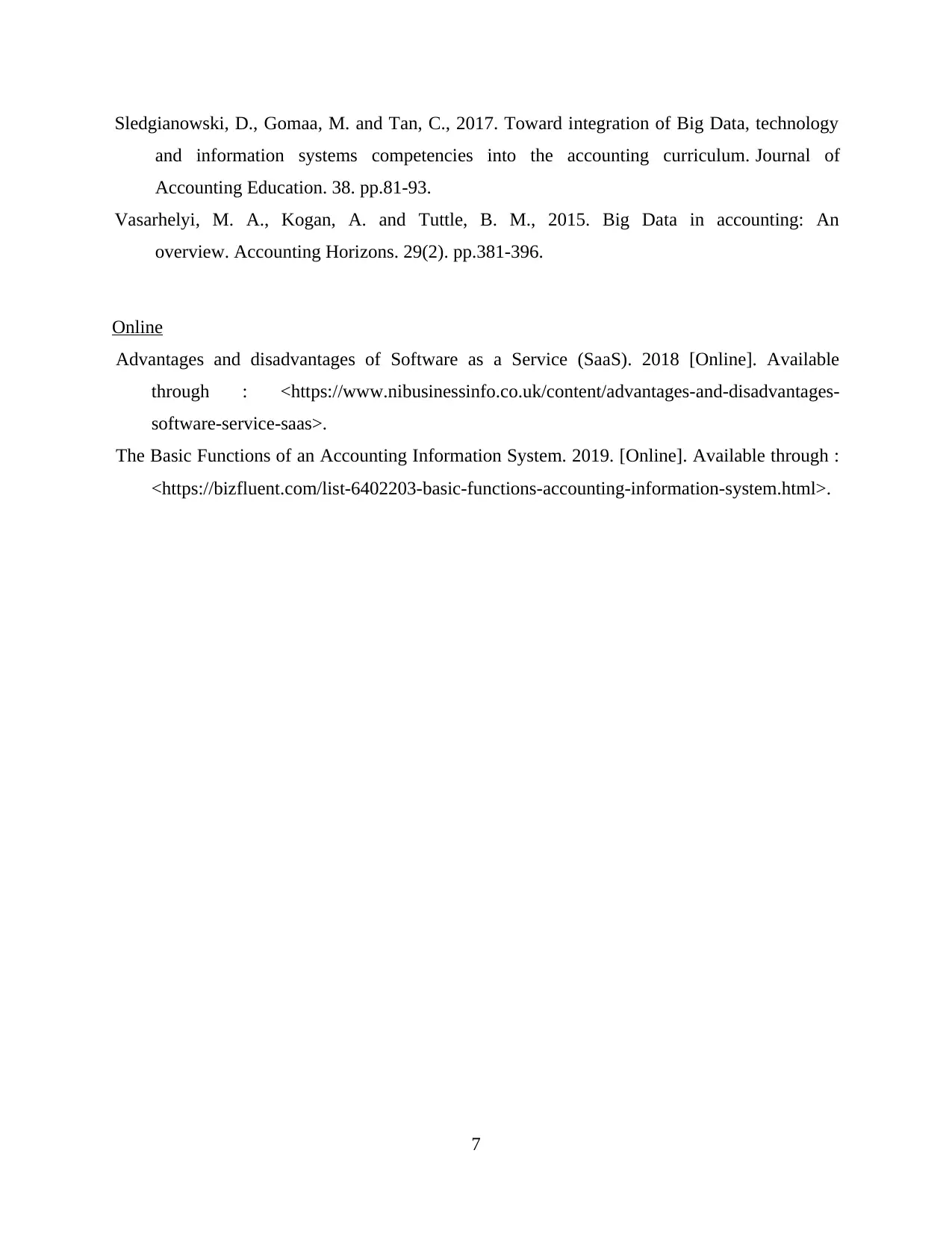
Sledgianowski, D., Gomaa, M. and Tan, C., 2017. Toward integration of Big Data, technology
and information systems competencies into the accounting curriculum. Journal of
Accounting Education. 38. pp.81-93.
Vasarhelyi, M. A., Kogan, A. and Tuttle, B. M., 2015. Big Data in accounting: An
overview. Accounting Horizons. 29(2). pp.381-396.
Online
Advantages and disadvantages of Software as a Service (SaaS). 2018 [Online]. Available
through : <https://www.nibusinessinfo.co.uk/content/advantages-and-disadvantages-
software-service-saas>.
The Basic Functions of an Accounting Information System. 2019. [Online]. Available through :
<https://bizfluent.com/list-6402203-basic-functions-accounting-information-system.html>.
7
and information systems competencies into the accounting curriculum. Journal of
Accounting Education. 38. pp.81-93.
Vasarhelyi, M. A., Kogan, A. and Tuttle, B. M., 2015. Big Data in accounting: An
overview. Accounting Horizons. 29(2). pp.381-396.
Online
Advantages and disadvantages of Software as a Service (SaaS). 2018 [Online]. Available
through : <https://www.nibusinessinfo.co.uk/content/advantages-and-disadvantages-
software-service-saas>.
The Basic Functions of an Accounting Information System. 2019. [Online]. Available through :
<https://bizfluent.com/list-6402203-basic-functions-accounting-information-system.html>.
7
⊘ This is a preview!⊘
Do you want full access?
Subscribe today to unlock all pages.

Trusted by 1+ million students worldwide
1 out of 9
Related Documents
Your All-in-One AI-Powered Toolkit for Academic Success.
+13062052269
info@desklib.com
Available 24*7 on WhatsApp / Email
![[object Object]](/_next/static/media/star-bottom.7253800d.svg)
Unlock your academic potential
Copyright © 2020–2025 A2Z Services. All Rights Reserved. Developed and managed by ZUCOL.





